
Euthalia aconthea, the common baron, often called simply baron, is a medium-sized nymphalid butterfly native to Sri Lanka, India and southeast Asia. It flies with stiff wing beats and often glides. The wing is not flapped very far below the horizontal.
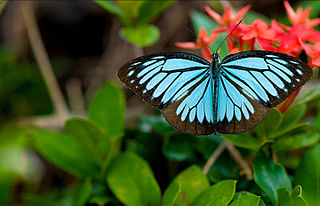
Pareronia valeria, the common wanderer or Malayan wanderer, is a medium-sized butterfly of the family Pieridae, that is, the yellows and whites, and is found in India and Southeast Asia. The butterfly found in India is sometimes considered as a separate species, Pareronia hippia.

Meandrusa payeni, the yellow gorgon, is a species of swallowtail found in parts of South Asia and Southeast Asia. It belongs to the hooked swallowtails genus, Meandrusa, of the family Papilionidae. It is also called the outlet sword or the sickle.

Cepora nadina, the lesser gull, is a small to medium-sized butterfly of the family Pieridae, that is, the yellows and whites. The species was first described by Hippolyte Lucas in 1852. It is native to Sri Lanka, India, Myanmar, Hainan, and southeast Asia.

Polyura schreiber, the blue nawab, is a butterfly species found in tropical Asia. It belongs to the Charaxinae in the brush-footed butterfly family (Nymphalidae). It occurs from south India and Assam through Myanmar, Tenasserim, and Southeast Asia to southern China and to Java, Indonesia.

Polyura eudamippus, the great nawab, is a butterfly found in India and the Indomalayan realm that belongs to the rajahs and nawabs group of the brush-footed butterflies.

Jamides bochus, the dark cerulean, is a small butterfly found in Indomalayan realm that belongs to the lycaenids or blues family. The species was first described by Caspar Stoll in 1782.

Jamides celeno, the common cerulean, is a small butterfly found in Indomalayan realm belonging to the lycaenids or blues family. The species was first described by Pieter Cramer in 1775.

Jamides kankena, the glistening cerulean, is a small butterfly found in India that belongs to the lycaenids or blues family.
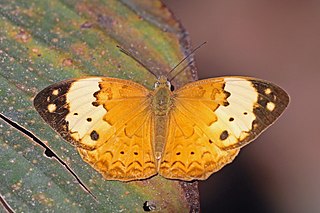
Cupha erymanthis, the rustic, is a species of brush-footed butterfly found in forested areas of tropical South Asia and Southeast Asia. The males and females are identical.
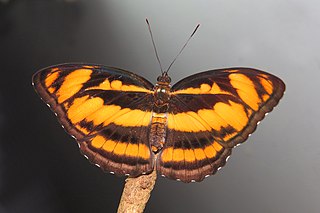
Athyma nefte, the colour sergeant, is a species of brush-footed butterfly found in tropical South and Southeast Asia.
Plebejus christophi, the small jewel blue, is a small butterfly found in Asia that belongs to the lycaenids or blues family.

Vindula erota, the common cruiser, is a species of nymphalid butterfly found in forested areas of tropical South Asia and Southeast Asia.

The Indian fritillary is a species of butterfly of the nymphalid or brush-footed family. It is usually found from south and southeast Asia to Australia.

Calinaga buddha, the freak, is a species of butterfly in the Calinaginae subfamily that is found in parts of Southeast Asia, China and India.

Leptostylopsis annulipes is a species of longhorn beetles of the subfamily Lamiinae.

Calliphara nobilis is a species of jewel bug found in Asia. Like all species of jewel bugs, it is phytophagous, feeding on the leaves, fruit and seeds of its host plants. This insect is notable for its multiple defense mechanisms: it is highly mobile and swarms disperse with a loud buzz when disturbed; it is aposematically colored, which serves as a warning to any would-be predators that it is unpalatable; and it possesses a robust chemical defense mechanism: it can secrete an irritating and toxic fluid from a pair of metathoracic scent glands when threatened.
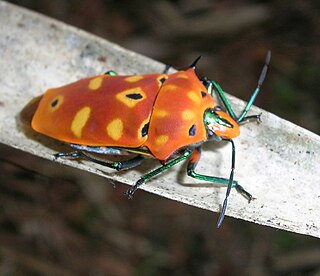
Cantao ocellatus is a species of shield bug in the family Scutelleridae found across Asia. Reddish or ochre in overall colour it has dark legs and bluish black antennae. A dark bluish black stripe is present along the central line of the head. The pronotum sometimes has two black spots on the front margin and sometimes has eight spots. The scutellum has eight or six black spots of variable size but with yellowish borders. The lateral angle of the pronotum is elongated into a curved spine but this can be much reduced. A distinctive symbiotic bacterial genus Sodalis from phylum Gammaproteobacteria is found in its midgut. Maternal care of eggs and nymphs has been noted in this species. The female stands over and covers the eggs after they are laid but eggs on the edge that she cannot cover are often parasitized by wasps.
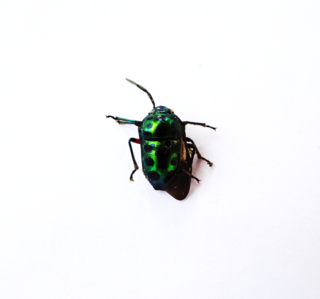
Chrysocoris patricius is a jewel bug in the family Scutelleridae. It is the smallest known species from the genus Chrysocoris.
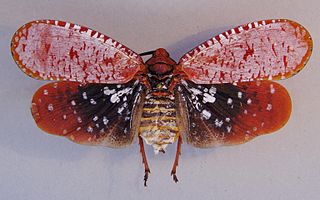
Aphaena submaculata is a species of planthoppers in the sub-family Aphaeninae of Fulgoridae. Various subspecies are distributed throughout the Indo-China region.



















